
Email Marketing Guide For Nonprofits [2025]
Doing email marketing for nonprofits is an effective way to keep in touch with your supporters, build connections, and lead them to action. As you probably know, email is one of the most powerful tools to engage your audience. Plus, it is cost-effective and easy-to-use, allowing NPOs to establish a line of communication with donors and subscribers.
Today, we are going to see how to build a nonprofit email marketing strategy, by looking at:
- the benefits of email for NPOs
- strategies you need to follow
- effective email newsletter examples
Without further ado, let’s roll!
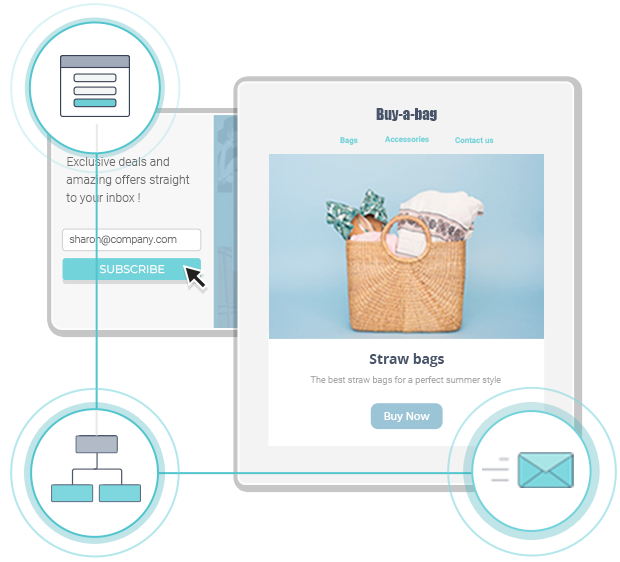
The easiest and most affordable email marketing and newsletter software!
Benefits Of Email Marketing For Nonprofit Organizations
Apart from the cost-effectiveness of email as a marketing tool, nonprofits can also use it to:
- build an audience of loyal supporters
- share news with them
- show them new action plans
- promote fundraising campaigns
Email marketing has a plethora of benefits. Among others, you can create personalized messages for your supporters through two processes called segmentation and personalization.
You can craft various email types to suit your needs, from awareness campaigns to thank you messages, and so on. Moreover, email is a powerful tool to increase your nonprofit website traffic and enhance your content. So you can use it to help your blog posts rank higher in search engines. And did we mention that email has the highest return on investment with an ROI of $42 for every $1 you spend?
In a nutshell, email marketing is a simple, cost-efficient, and easy-to-grasp digital marketing strategy you can follow to promote your NPO. Below, let’s see the tactics you can follow to start on the right foot.
7 Steps To Build A Nonprofit Email Marketing Strategy
Now that you know some of the benefits of email marketing for nonprofits, it’s time to check the best ways to make it a reality.
1. Start Building Your Email List
A nurtured email marketing list is the first thing you need to set the gears in motion. To create it, you can use newsletter signup forms and landing pages to collect your potential donors’ and supporters’ email addresses.
The easiest way to do that is to add a popup to your website. You can choose the type you want to display (inline, floating box, etc) and the number of fields you like them to complete before they register. Remember, simple forms are more effective and less intrusive than complex popups with numerous fields.
As a rule of thumb, try to create a very simple newsletter sign-up process to increase your registration rate and build your mailing list as fast as possible.
Below, you can see an example by Doctors of the World:
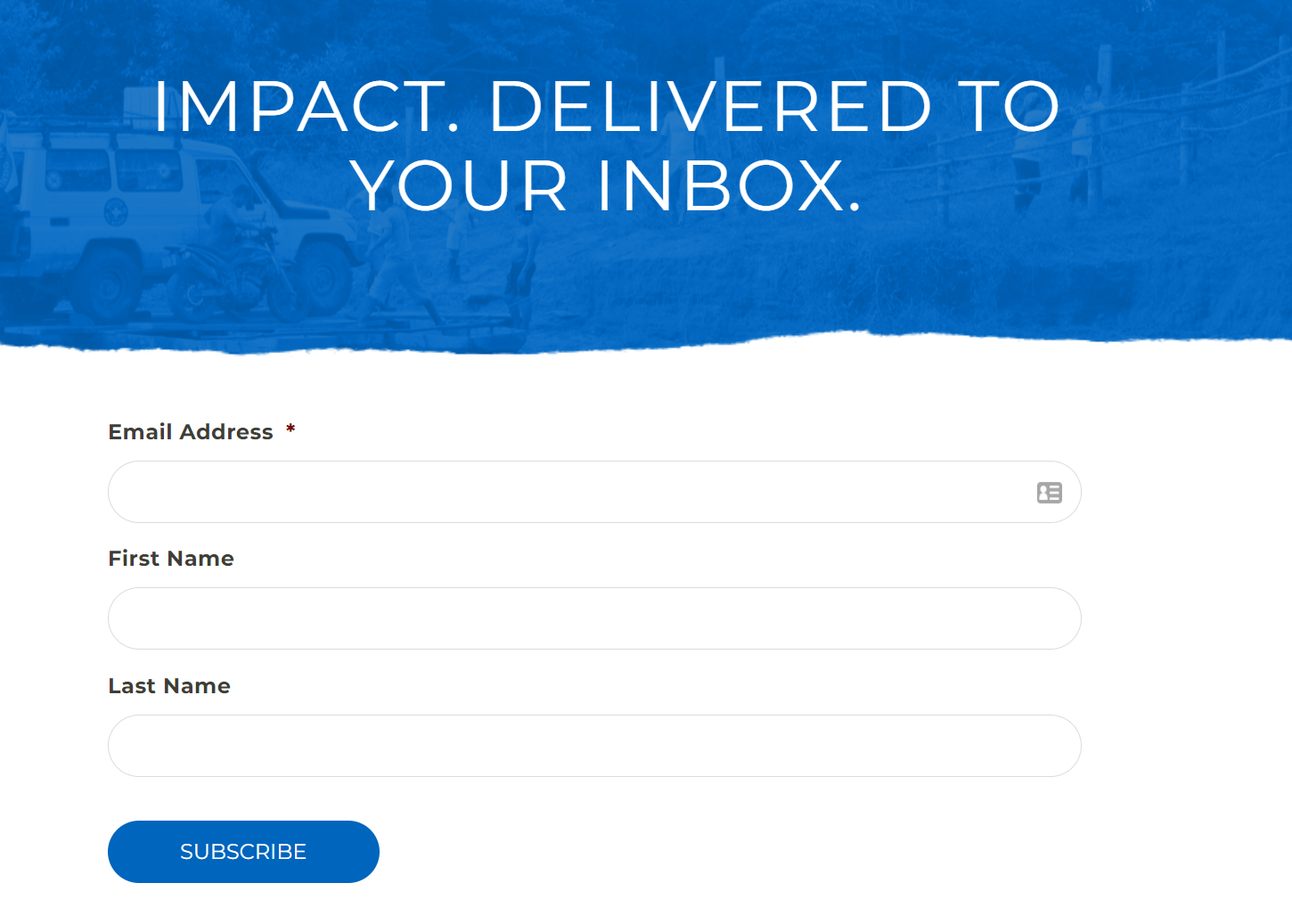
While speed is crucial to begin your email marketing efforts, having quality contacts is also an important thing to consider.
To avoid spam accounts and invalid email addresses, things that will hinder your email deliverability (i.e. your ability to reach the inbox), you need to enable the double opt-in process. This extra step requires your visitors to verify their email addresses before they end up on your list. While it adds an extra step to the process, it’s crucial to make sure that your email lists are clean and engaged.
Now to create the above lead capturing forms, you will need to get your hands on an online form builder. Using Moosend’s email marketing platform is a great idea to get started as it gives you one along with the email and landing page editors.
This way, you won’t break the bank and get started with an easy-to-use tool that provides you with all the functionality you need. Try it out by signing up for a Moosend account today.
2. Segment Your New Contacts
Email list segmentation is one of the things you need to know about before you start building your mailing lists. This process allows you to group your contacts based on similar criteria and interests.
For example, you can divide your new subscribers into categories based on:
- Demographics
- Location
- Profession
- Interests
Now, the best way to segment your audience is to add the necessary fields to your form. This way, you will be able to perform this process as early as possible. Here’s a very simple segmentation example by the Center of Constitutional Rights:
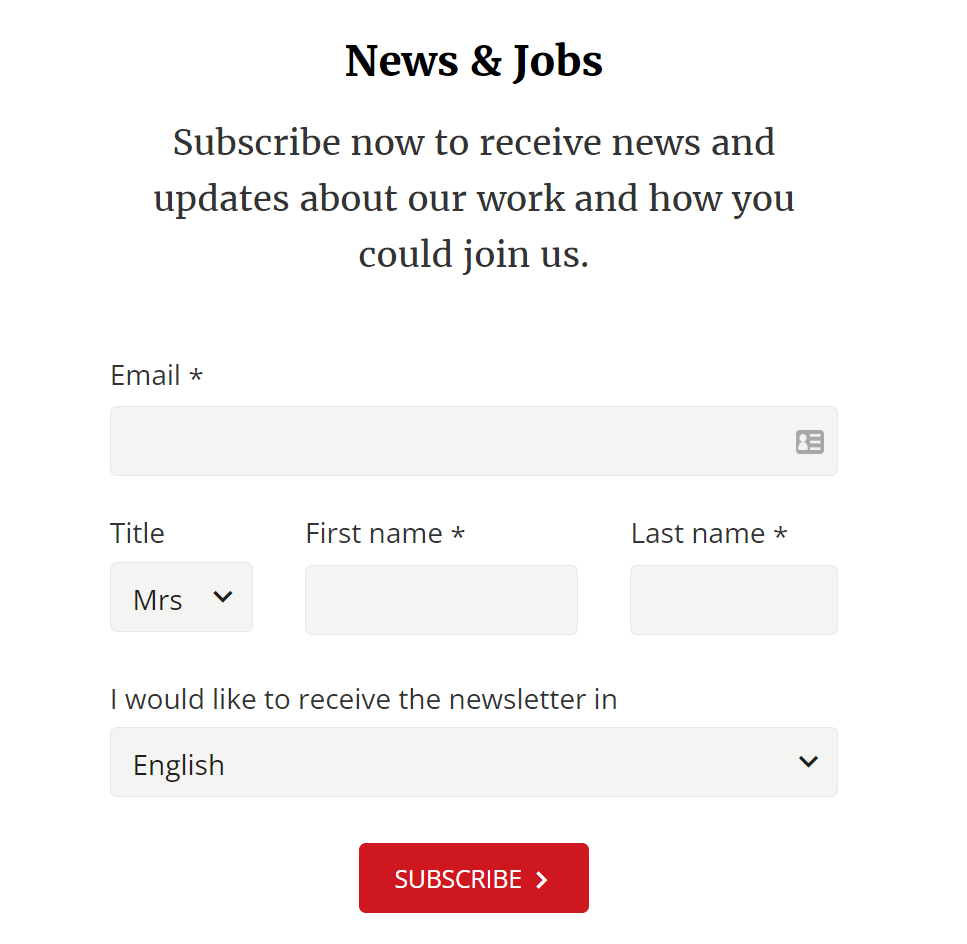
As you can see, the nonprofit organization asks for the recipient’s first and last name, along with their country and ZIP/postal code. This way, the NPO can segment their new subscriber based on their location. Furthermore, it also lets them select the language they want to receive the newsletter in to improve their experience.
This way, the nonprofit organization will manage to deliver more relevant content to their new contacts. So now that you got this information and grouped them into segments, what do you do next?
3. Personalize Your Email Content
Along with segmentation comes personalization, another crucial process to increase the effectiveness of your nonprofit email marketing strategy. By collecting vital information like your subscriber’s location, demographics, and engagement, you can automatically create messages tailored to them.
The most basic form of personalization entails the inclusion of your contact’s first name to make the campaign more personal and friendly.
The following email by the Children’s Defense Fund shows a very simple example, focusing on using the subscriber’s name to establish a connection with them and increase rapport.
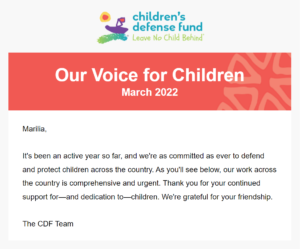
Apart from that, modern email marketing software allows you to take that one step further. For example, you can now use conditional visibility content to display targeted campaign content to your subscribers.
This way, recipients from a specific country can see localized news/actions or receive additional incentives. As a result, you can use the information collected through your newsletter signup forms to tailor your campaigns to every subscriber, from actions to special discounts and more.
4. Craft Your Campaign Subject Lines
Before you send your NPO email marketing campaigns, you need to consider your subject lines. These lines of text are the most important part of your emails as they determine whether your subscribers will open your messages or not.
Great email subject lines will give you the open rate you need to reach your email campaign goals and achieve high engagement. Below, you can see a few handy tips to keep in mind when you create yours:
- keep them short and to the point
- highlight the benefit of interacting with the campaign
- add urgency while being honest
- avoid spammy words
Creating effective subject lines isn’t rocket science. They just need to be straightforward and intriguing to promote action. Now let’s see a few examples from popular nonprofits out there to get you inspired:
- Update on our work for children (Children’s Defense Fund)
- Marilia, join us this World Wildlife Day (WWF)
- Your gift DOUBLED to help Ukrainian refugees (Human Rights Watch)
- On this Valentine’s Day, our hearts go out to Haiti ❤ (Doctors of the World)
Using the right email subject line is essential to increase your open rates and click-throughs. So before you write yours, make sure that you check the above and then start.
5. Create The Right Email Marketing Campaigns For Nonprofits
Your nonprofit organization campaigns also need to be carefully planned. From welcome series to thank you emails, your NPO needs the right tool to create the right campaign at the right time!
You may think, can’t I just email my audience through my Gmail account? Well, you can, but it won’t have the same impact as delivering professional-looking campaigns sent from an official organization email address. For that, you need one of the best email marketing tools that are NPO-friendly like Moosend, Campaign Monitor, or Mailchimp.
Moosend, for example, is an email marketing tool that NPOs like WWF use to promote action and update their subscribers. More specifically, getting an advanced tool will give you:
- an email builder to craft your messages
- responsive email templates for mobile devices
- CRM tool/integrations to manage your email subscribers
- sign up forms and landing pages
- segmentation and personalization tools
- marketing automation and a/b testing
All of the above features will allow you to run your NPO email marketing strategy on autopilot. Make sure to sign up for a Moosend account to try out the email builder and check out the rest of the features. For more, you can easily upgrade to a paid plan. Pricing starts at $9/month and you’ll get access to all the features, including the SMTP server for transactional emails, audience management, personalization, and more.
Now that you know what you need to create your email newsletters, let’s see a few essential types you need to send.
Welcome Email Series
Making a great first impression with your welcome email is the most important thing in your email marketing for NPOs strategy. So when you email your new subscriber for the first time, your messages need to be friendly, highlighting the impact of joining and what they can expect.
Let’s see this example by Save the Children:
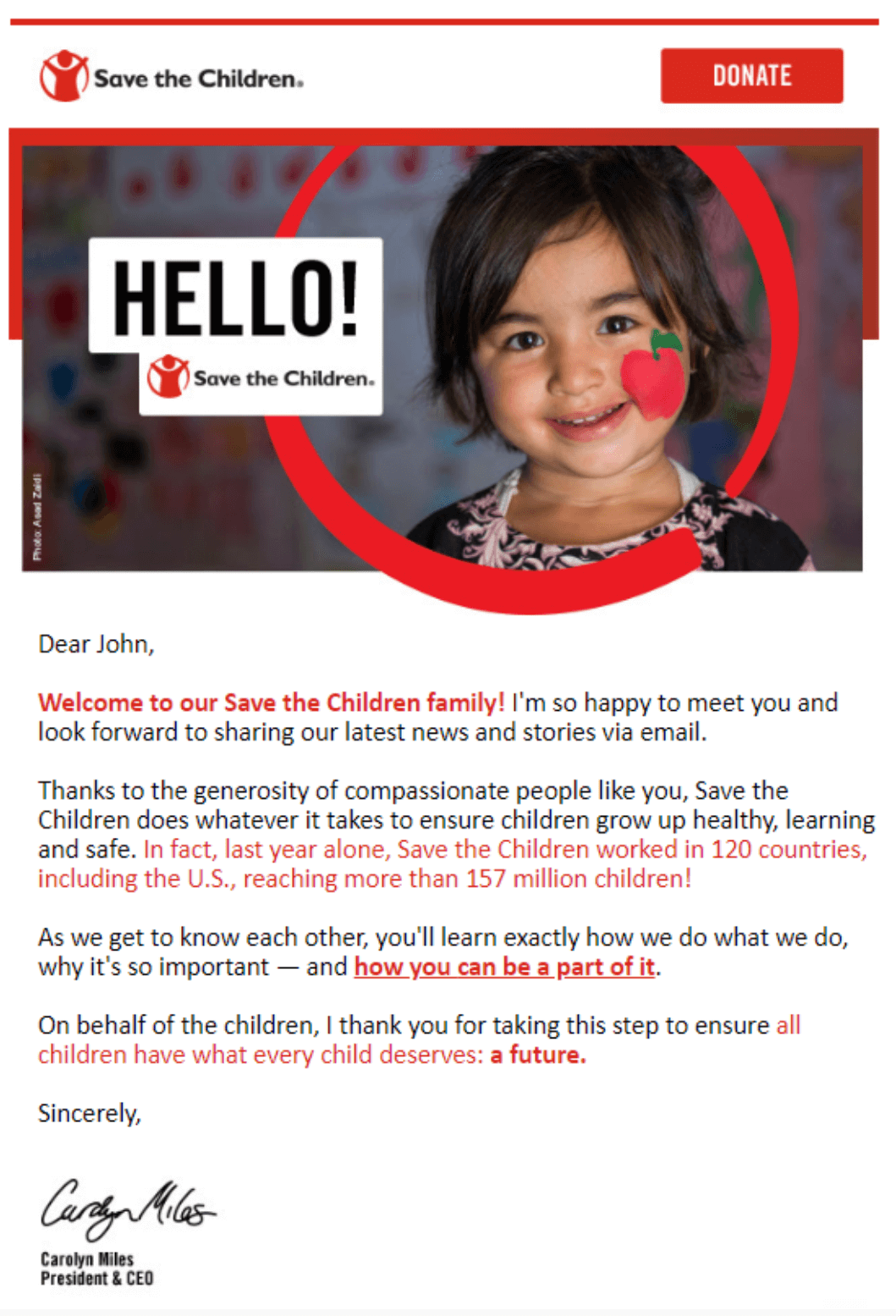
The above welcome campaign uses an array of elements to educate new email subscribers and promote action. The visual of the smiling child on top is also meant to connect the organization with the cause.
When it comes to the copy, the NPO uses short chunks of text to welcome the supporter and let them know about their goals.
Lastly, they also use the subscriber’s name to make it friendlier and add the CEO’s name and signature to appear more personal to the recipient.
Update Campaigns
You can set up a weekly or bi-weekly email newsletter to keep your audience engaged and up-to-date with current affairs. Make sure to keep a consistent mailing schedule, though, to promote engagement and maintain good email deliverability.
Now let’s see an amazing example by WWF:
Subject line: Your weekly roundup from WWF 🐼
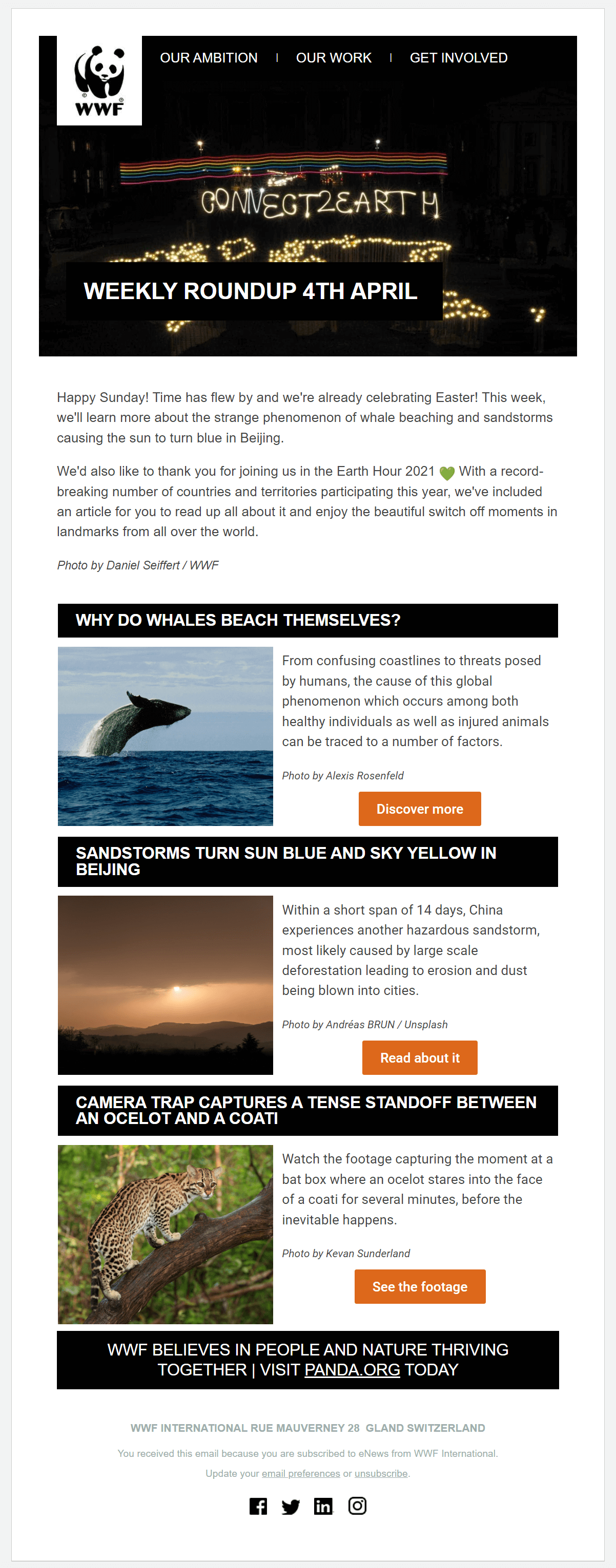
The organization uses this weekly roundup campaign to keep email subscribers updated about ongoing and upcoming events.
Moreover, they have included a variety of sections promoting different topics to increase awareness and educate their audience about important environmental issues. Design-wise, this update campaign is very simple and informative, sporting an easy-to-read layout and brightly colored CTAs to attract attention.
What’s more, WWF adds social buttons to cross-promote between its email and social media channels like Facebook and LinkedIn. That’s an excellent way to boost your traffic and engagement on different channels.
Want to mimic WWF’s brilliant update campaigns? Make sure to sign up for a Moosend account and hop into the editor to try out its capabilities.
Donation Promotion
To fund your cause, your nonprofit is going to need the support of your audience, namely your donors. As mentioned above, email is a great channel to keep in touch with them and build strong relationships.
Below, you can see how Doctors of the World have crafted a dedicated email campaign to promote donations for an emergency medical appeal.
Subject line: Ukraine Emergency Appeal
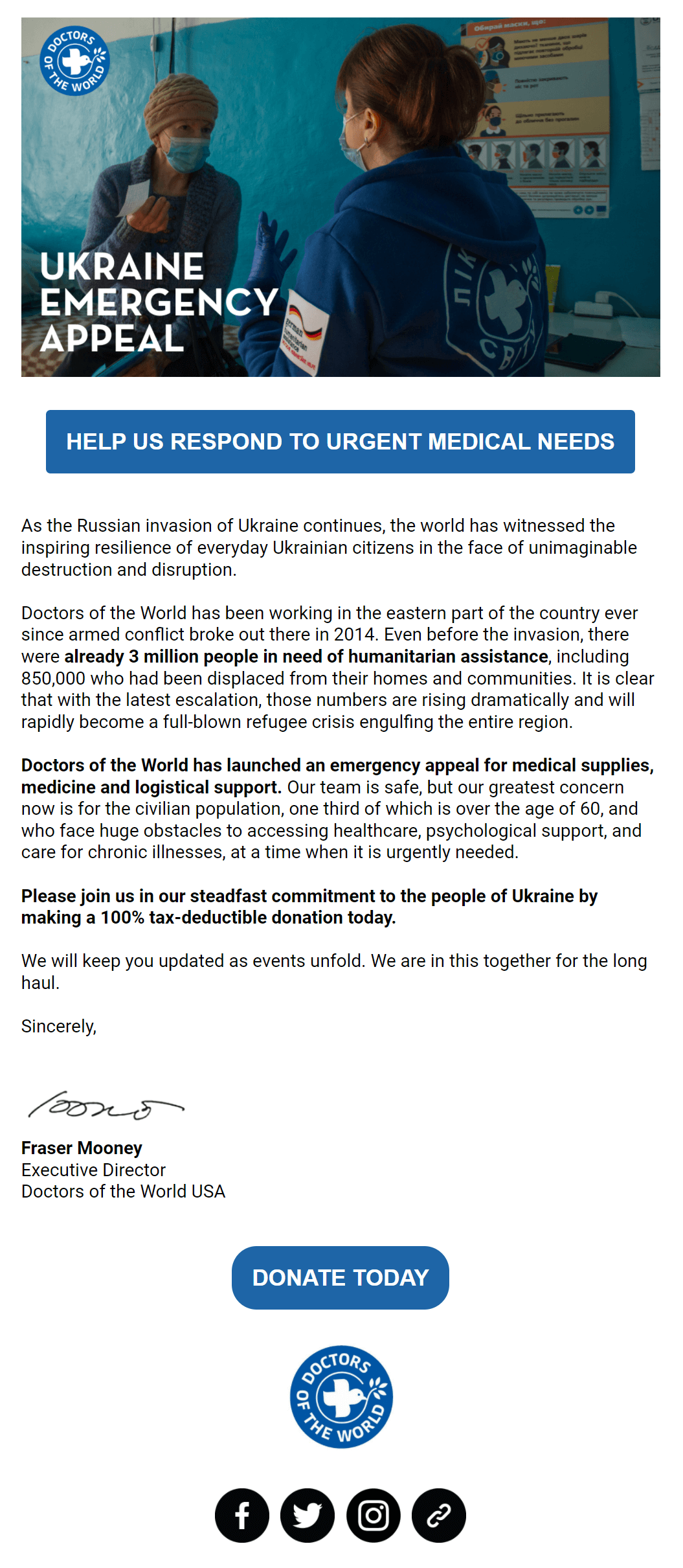
The NPO uses a straightforward email subject line to introduce the topic of this campaign. When it comes to the design, the organization also uses an image to balance the large email copy found underneath. Here, the visual is related to the message, increasing engagement with the campaign.
What’s more, you should always try to keep your email copy short to avoid friction. Nevertheless, the nonprofit organization uses bold to highlight the most important part of the message, which is making a donation.
For the CTAs, the NPO uses two buttons to promote action. The first one is strategically placed above the fold to attract attention to the desired action through urgent language. The second one is found at the bottom of the campaign to catch the subscribers who didn’t engage with the one on top.
Thank You Emails
Of course, if your email subscribers make a donation, you should send them a thank you email to show your appreciation for supporting your cause. Let’s see an example by Earthjustice:
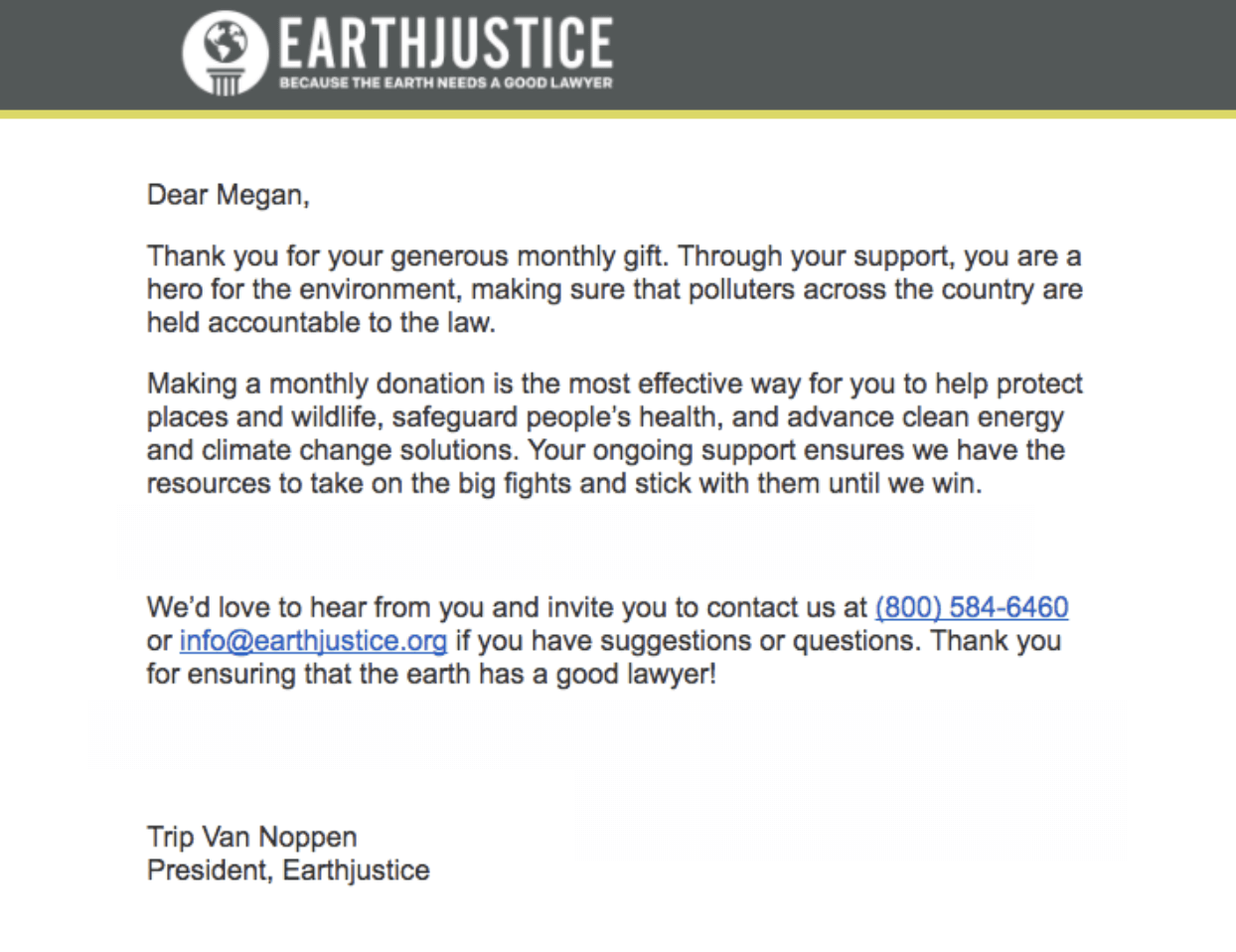
The NPO has created a short message to thank the donor for their monthly contribution. As you can see, adding their first name makes the copy more friendly and meaningful. What’s more, you can highlight the impact your subscriber will make and the importance of donating to the cause.
Apart from that, the nonprofit adds a telephone number and an email address, encouraging the donor to contact them in case they have questions or feedback. This is an excellent idea to get your supporters involved in the process and make sure that they are informed about your actions.
Lastly, the email signature at the end with the president’s name is essential to increase credibility and make the donor feel like the email comes from a personal email address.
Tip: Don’t forget to add an unsubscribe link to your email to allow disengaged contacts to leave your mailing list. This may not sound ideal but it will actually promote your email list cleaning efforts.
The above campaigns are some of the most crucial messages your NPO needs to deliver. Nevertheless, based on your goals you can create more, including:
- Online fundraising event campaigns
- Webinar emails
- Holiday messages
- Collaboration, and more
6. Take Advantage of Marketing Automation
Marketing automation can come in handy as you grow your NPO audience. This tool allows you to automate your email marketing process by creating workflows. These will let you target your audience with the right message at the right time.
For instance, you can craft an automated welcome email series with different follow-up messages triggered after specific user actions. This way, you can personalize your new subscriber’s experience and increase their chances of staying with you.
Apart from that, you can use email marketing automation to craft a variety of email sequences, including:
- cart abandonment campaigns (if you’re also selling charity items)
- re-engagement series
- surveys and feedback emails
- anniversary and more
With a visual builder, you can create the automations you like in a few minutes, such as repeat donations for your NPO and more.
Interested to see how marketing automation works? Make sure to register for a Moosend account and take the visual workflow editor for a spin.
7. Optimize Your NPO Email Strategy
The above strategies will work in your favor but to ensure continuous success, you have to improve your NPO email tactics regularly.
The best way to do so is to track your email marketing metrics. Among others, you have to pay attention to your:
- Open rates
- Click-throughs (CTR)
- Conversions
- Bounce rate
- Unsubscribe rate
Monitoring the above indicators through your platform’s reporting and analytics section will allow you to identify problems and opportunities. For instance, if your campaigns have a low open rate, you might want to revisit your subject lines. If your conversions are suffering, too, you can focus on improving your CTAs and your email copy.
Your greatest ally to optimizing your campaigns is A/B Testing, a process that lets you send different variations of your email to discover the winning combination. Performing regular A/B tests on a variety of elements is a simple and effective way to discover what your audience likes and dislikes.
This feature is available to use on most email marketing platforms like Moosend and Mailchimp. Nevertheless, always check out your tools as services like Constant Contact only offer subject line A/B Testing, which can be restricting.
Building Your Email Marketing For Nonprofits Strategy
Promoting your NPO isn’t a great feat but it will require time, the right strategies, and a few tools to get it done.
Start with list building and then segment your audience to increase your engagement efforts through personalization. Make your subject lines and come up with your email campaigns to fulfill your marketing goals.
Lastly, don’t forget to leverage marketing automation and optimize your NPO email strategy for better results!
You can start your email marketing adventure to promote a more sustainable future by signing up for a Moosend account!
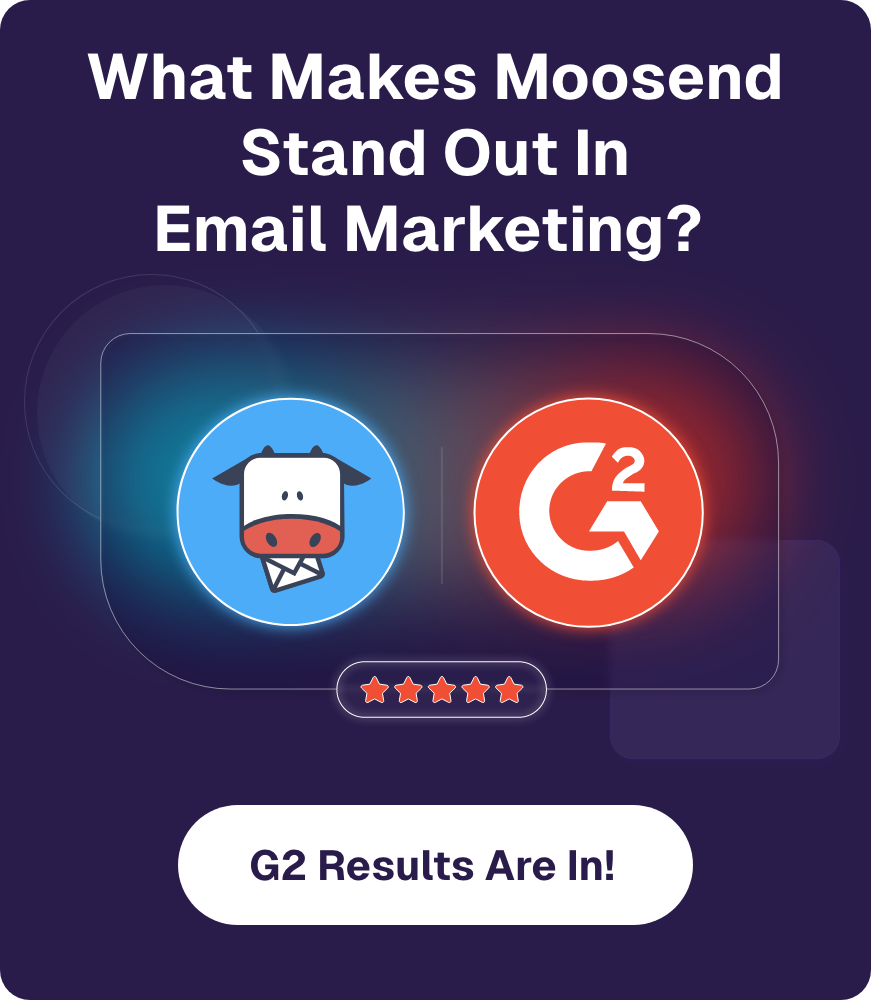

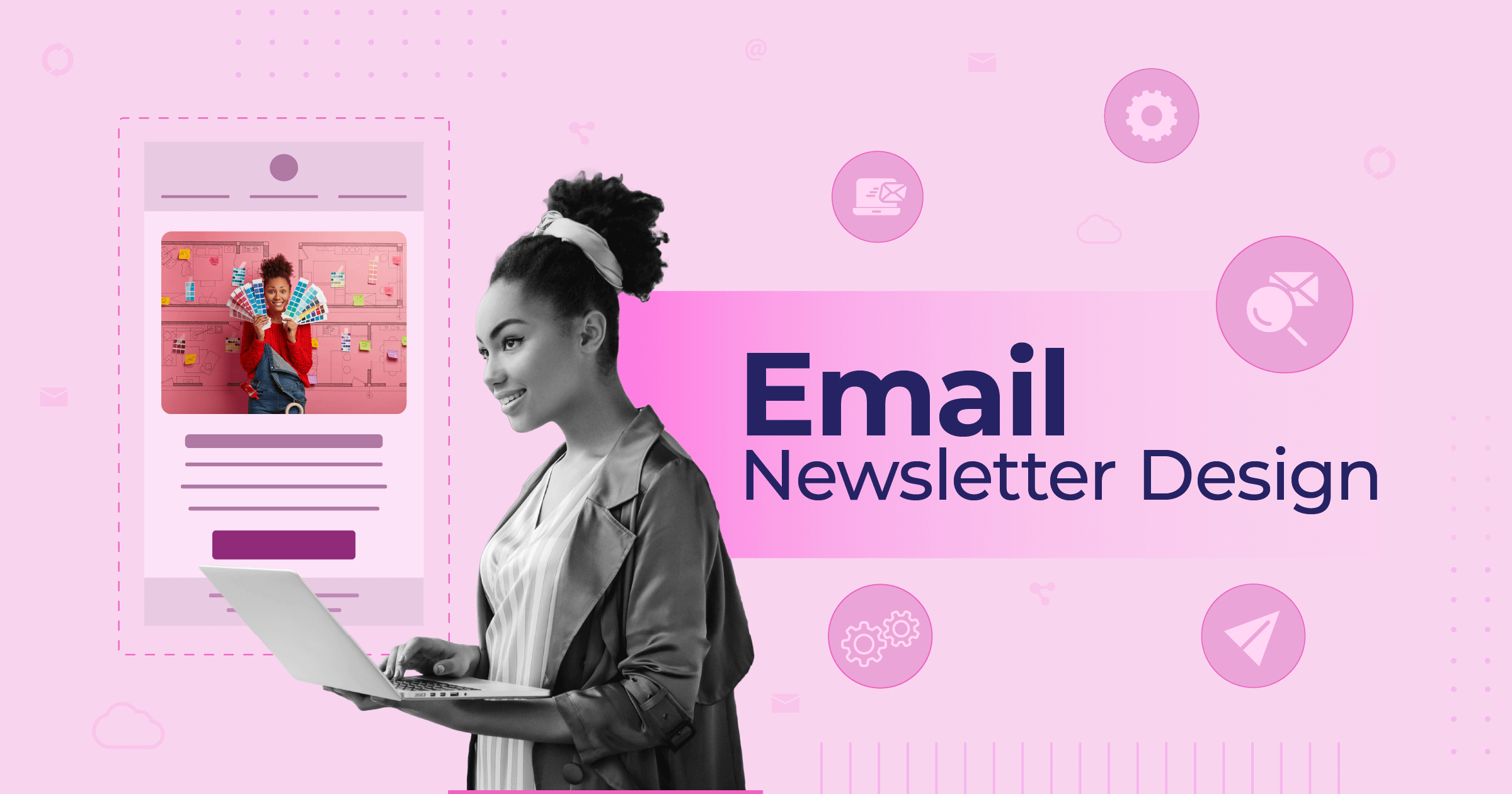
 Published by
Published by
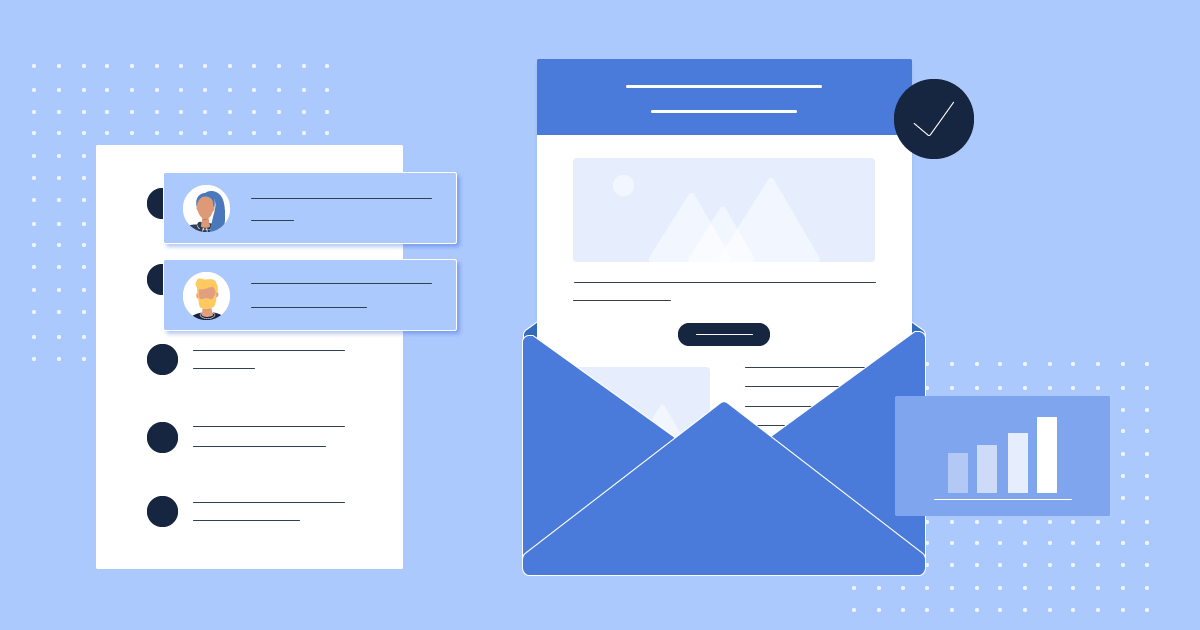
 Published by
Published by
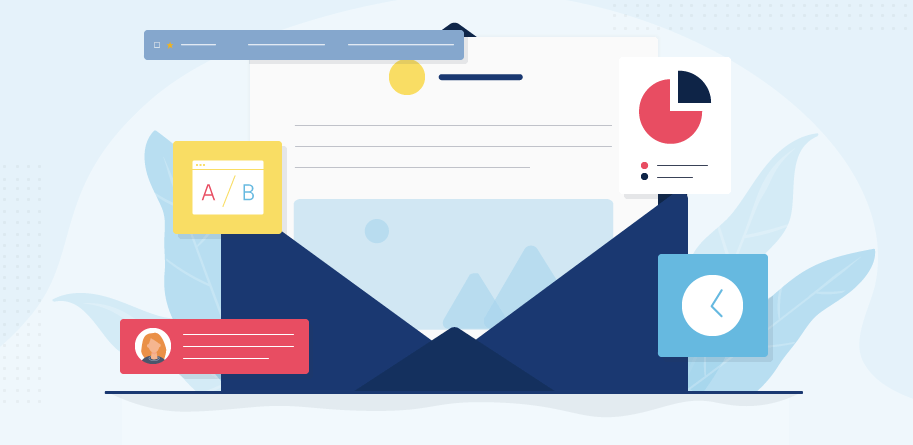
 Published by
Published by